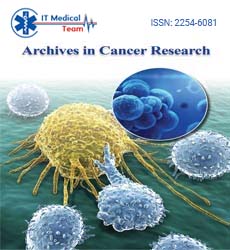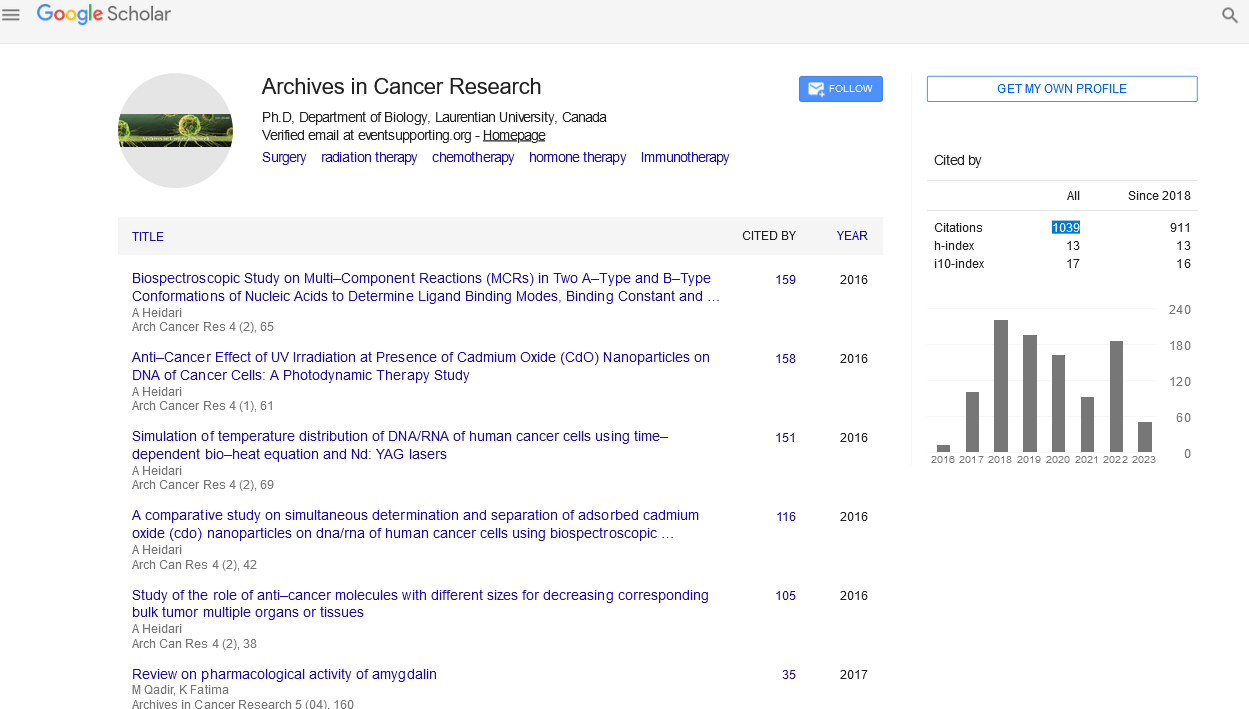Perspective - (2024) Volume 12, Issue 6
Chemotherapy: A Vital Treatment in the Battle Against Cancer
Dipa Schulte*
Department of Oncology, Harvard Medical School, Boston, United States
*Correspondence:
Dipa Schulte, Department of Oncology, Harvard Medical School, Boston,
United States,
Email:
Received: 14-Nov-2024, Manuscript No. IPACR-24-15351;
Editor assigned: 19-Nov-2024, Pre QC No. IPACR-24-15351 (PQ);
Reviewed: 03-Dec-2024, QC No. IPACR-24-15351;
Revised: 13-Dec-2024, Manuscript No. IPACR-24-15351 (R);
Published:
20-Dec-2024
Introduction
Chemotherapy is one of the cornerstone treatments for
cancer, often used to destroy or shrink tumors and eliminate
cancer cells in the body. Since its introduction in the 1940's,
chemotherapy has undergone significant advancements, making
it a key component in cancer management today. This article
explores the mechanisms, applications, side effects, and future
developments of chemotherapy in the fight against cancer.
Description
Chemotherapy refers to a class of drugs that are used to treat
cancer by targeting rapidly dividing cells, a hallmark of cancer
cells. These drugs can be administered orally, intravenously, or
through injections, depending on the type of cancer being
treated and the drugs being used. Chemotherapy works by
interfering with the DNA within cells, preventing them from
dividing and growing. Cancer cells, which divide more frequently
than normal cells, are particularly sensitive to these treatments.
However, chemotherapy does not exclusively target cancer
cells. Healthy cells that also divide rapidly, such as those in the
bone marrow, digestive tract, and hair follicles, can be affected,
leading to the common side effects of chemotherapy.
Mechanisms of chemotherapy
Chemotherapy drugs operate through several different
mechanisms to destroy cancer cells.
DNA interference: Many chemotherapy agents work by
interfering with the DNA in cancer cells. This may include drugs
that inhibit the enzymes necessary for DNA replication or
directly damage the DNA structure, preventing cancer cells from
dividing and proliferating.
Mitotic inhibition: Some chemotherapy drugs inhibit the
process of mitosis, which is the division of cells. These drugs
prevent the cancer cells from dividing and growing, eventually
leading to their death.
Inducing apoptosis: Chemotherapy can also trigger apoptosis,
or programmed cell death, in cancer cells. Certain chemotherapy
agents cause cancer cells to self-destruct by initiating a cascade
of molecular events that lead to cell death.
Targeting the tumor microenvironment: Recent advancements
in chemotherapy have led to drugs that also target the tumor
microenvironment, affecting the blood vessels, immune cells,
and extracellular matrix surrounding the tumor, which are
essential for the tumor's growth and survival.
Types of chemotherapy drugs
Chemotherapy drugs are classified into several categories
based on their mechanism of action. Some of the main
categories include.
Alkylating agents: These drugs work by adding an alkyl group
to the DNA molecule, causing damage that prevents DNA
replication. Examples include cyclophosphamide and ifosfamide.
Antimetabolites: These drugs mimic the building blocks of
DNA and RNA, thereby disrupting the synthesis of these crucial
molecules and inhibiting cancer cell division. Examples include
methotrexate and 5-fluorouracil.
Antitumor antibiotics: These drugs are derived from bacteria
and work by interfering with the cancer cell's DNA, preventing
replication. An example is doxorubicin.
Plant alkaloids: Derived from plants, these drugs disrupt the
process of cell division. Paclitaxel and vincristine are two wellknown
plant alkaloids used in chemotherapy.
Topoisomerase inhibitors: These drugs inhibit enzymes that
are responsible for untwisting the DNA helix, which is necessary
for DNA replication. Drugs in this category include etoposide and
irinotecan.
Targeted therapies and immunotherapies: Although not
traditionally classified as chemotherapy, these treatments focus
on specific molecular targets involved in cancer cell growth and
survival, such as monoclonal antibodies or small molecule
inhibitors. Examples include trastuzumab (Herceptin) for
breast cancer and rituximab for lymphoma.
Applications of chemotherapy
Chemotherapy is used in various ways in cancer treatment.
Adjuvant therapy: Chemotherapy is often given after surgery
to eliminate any remaining cancer cells, reducing the risk of
recurrence. This is particularly common in cancers like breast,
colon, and lung cancer.
Neoadjuvant therapy: Chemotherapy may be used before
surgery to shrink a tumor, making it easier to remove and
increasing the chances of a successful surgery.
Palliative chemotherapy: In cases where the cancer is
advanced and not curable, chemotherapy may be used to relieve
symptoms, shrink tumors, and improve the quality of life for
patients.
Curative chemotherapy: In some cases, chemotherapy alone
can cure cancer, especially in cancers like leukemia, lymphoma,
and testicular cancer. Chemotherapy may also be used in
combination with other treatments like radiation therapy and
immunotherapy to increase the likelihood of a cure.
Chemotherapy for metastatic cancer: Chemotherapy is also
commonly used to treat cancers that have spread to other parts
of the body (metastasis), helping to control the spread and
growth of cancer cells.
Side effects of chemotherapy
While chemotherapy can be highly effective, it is also
associated with a range of side effects. These side effects occur
because chemotherapy drugs not only target cancer cells but
also affect healthy cells that divide rapidly. Some of the most
common side effects include.
Hair loss: Chemotherapy often causes hair loss because the
drugs target rapidly dividing cells, including those in hair follicles.
This side effect is temporary, and hair typically grows back after
treatment ends.
Nausea and vomiting: Chemotherapy drugs can irritate the
lining of the stomach, leading to nausea and vomiting. Antiemetic
drugs are often used to prevent or reduce this side effect.
Fatigue: Chemotherapy can cause significant fatigue due to its
impact on bone marrow, which affects the production of red
blood cells and leads to anemia.
Increased risk of infection: Since chemotherapy weakens the
immune system by affecting white blood cells, patients are more
susceptible to infections.
Mouth sores and digestive issues: Chemotherapy can
damage the cells lining the mouth, throat, and digestive tract, leading to sores, difficulty swallowing, and other gastrointestinal
issues.
Cognitive effects: Some patients experience "chemo brain," a
condition that can cause difficulty concentrating, memory
problems, and mental fatigue during and after treatment.
Long-term effects: In some cases, chemotherapy may
have long-term effects, including heart damage, nerve damage,
or an increased risk of secondary cancers.
Future of chemotherapy
The future of chemotherapy lies in enhancing its precision and
minimizing its side effects. Recent advances in the field of cancer
research have led to the development of targeted therapies and
immunotherapies, which are becoming increasingly integrated
with traditional chemotherapy treatments. These therapies
specifically target cancer cells with greater precision, thereby
sparing healthy cells and reducing side effects.
Additionally, personalized medicine is paving the way for
more effective chemotherapy regimens. By analyzing the genetic
makeup of both the patient and their tumor, oncologists can
better determine which chemotherapy drugs will be most
effective for a specific individual, improving outcomes and
reducing unnecessary side effects.
Researchers are also exploring the use of nanotechnology in
chemotherapy, using nanoparticles to deliver drugs directly to
the tumor site. This could help increase the drug concentration
in the tumor while minimizing exposure to healthy tissues.
Conclusion
Chemotherapy remains a cornerstone in cancer treatment,
providing significant benefits in both curative and palliative
contexts. While it can be associated with challenging side
effects, ongoing research and the development of more targeted
therapies offer hope for reducing these adverse effects and
improving outcomes for cancer patients. With the integration of
personalized approaches and advanced technologies, chemotherapy
will continue to evolve, offering more effective and less toxic
treatment options for cancer patients worldwide.
Citation: Schulte D (2024) Chemotherapy: A Vital Treatment in the Battle against Cancer. Archives Can Res Vol:12 No:6





